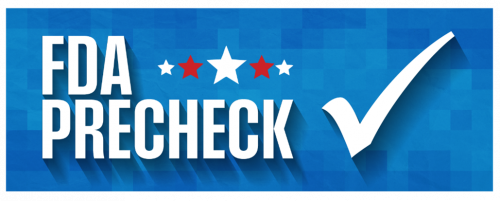The FDA Announces PreCheck: A Fast-Track for Building U.S. Drug Plants
A new two-phase “PreCheck” pathway could shave months off U.S. plant construction while turning early regulatory engagement into a competitive edge for drug makers.
The U.S. drug-supply chain is in the middle of a geopolitical tug-of-war, and every tug can add weeks—or even years—to the timeline for getting medicines from cleanroom to clinic.
After decades of watching production migrate to lower-cost hubs abroad, it seems Washington is now willing to take action to lure bricks, mortar, and stainless steel back onto American soil.
Enter FDA PreCheck, a two-phase fast-track that flips the traditional inspection sequence on its head: instead of waiting for a facility to be finished before regulators weigh in, the agency is offering design-stage feedback, rolling CMC dialogues, and a reusable Type V Drug Master File that can anchor multiple drug applications, according to a notice in the Federal Register.
Why the sudden urgency? Pandemic-era shortages exposed just how thin the margin of error is when 90 percent of active pharmaceutical ingredients originate overseas.
Since then, President Trump has dangled tariffs on imported drugs, a 180-day executive order has mandated regulatory “relief” for domestic plants, and the pharma industry has pledged billions of dollars for U.S. greenfield builds.
Yet all of that CAPAEX is meaningless if FDA inspections remain the long pole in the tent. PreCheck seems to be the agency’s answer: a structured engagement model that aims to prune months off construction schedules, front-load quality expectations, and—crucially—reduce the risk that a 483 lands on a project only after the paint is dry.
Let’s break this down based on what’s been announced.
What is FDA PreCheck?
FDA PreCheck is the agency’s proposed playbook for front-loading regulatory dialogue when a company decides to build—or significantly expand—a U.S. drug plant.
Crafted in response to Executive Order 14293, “Regulatory Relief to Promote Domestic Production of Critical Medicines,” the framework directs the FDA to cut duplicative requirements and “streamline and accelerate” domestic manufacturing reviews.
The stated objective of the program:
“support faster establishment of new U.S. pharmaceutical manufacturing capacity through earlier regulatory input, enhanced engagement, and efficient CMC assessments.”
The two-phase structure—how PreCheck actually works
Phase 1 is facility readiness. Before the first girder is even set, sponsors can invite FDA engineers and quality reviewers into the conversation. The agency offers pre-operational check-ins at each major milestone—initial design, construction planning, equipment qualification, and pre-production walkthroughs. Companies are also encouraged to open a Type V Drug Master File (DMF) that captures the facility’s blueprints, quality-system architecture, and quality-maturity practices in one living document.
Why this matters: Early feedback turns potential CGMP gaps into paper changes instead of million-dollar retrofits, and the DMF can be cited by multiple future NDAs, saving months every time the plant is referenced in a new application.
Phase 2 is application submission. Once a product dossier is taking shape, FDA shifts focus to drug-specific Chemistry, Manufacturing, and Controls (CMC). Pre-application meetings give reviewers and inspectors advance visibility into how the facility will support each filing and let sponsors resolve questions about process validation, data integrity, or inspection logistics before the review clock starts.
Why this matters: Front-loading CMC dialogue accelerates the quality assessment, reduces the odds of last-minute Form 483 findings, and shortens the overall timeline from submission to approval.
Backing up: why the program exists, and why now?
There’s a lot of context to this move, but suffice it to say that while globalization once promised cheaper medicines, it also created a single-point-of-failure risk the pandemic laid bare.
White House policy now treats onshoring as a national security imperative, and EO 14293 orders the FDA to “eliminate any duplicative or unnecessary requirements…[and] maximize the timeliness and predictability of agency review.”
PreCheck essentially translates that mandate into a concrete engagement model that can prune months from construction schedules and de-risk billion-dollar investments.
How FDA PreCheck works in practice
The FDA has outlined three core steps here:
Design-to-steel alignment. Sponsors share blueprints, clean-room zoning, and quality-system schematics early, letting FDA flag CGMP gaps.
Living facility dossier. A Type V DMF becomes a single source of truth that the agency can reference across applications, slashing redundant submissions.
Front-loaded CMC reviews. By the time an NDA arrives, inspectors already know where to look, and reviewers have vetted key quality elements.
Key dates and how to engage
The FDA is holding a public meeting on September 30, 2025 (9:00 am – 4:00 pm ET) at its White Oak campus, with virtual attendance available. The registration deadline for in-person seats is September 2 at 11:59 pm ET.
A few strategic implications for manufacturers
Here’s what’s coming to mind for us right away:
Firms may need clearer build timelines. With design-stage check-ins and pre-construction walkthroughs baked into Phase 1, sponsors can lock down critical-path milestones (steel erection, clean-room certification, utilities qualification) months earlier. That clarity lets finance teams stage capital disbursements in tranches tied to FDA sign-offs instead of broad contingencies—reducing idle cash on the balance sheet and minimizing the risk of cost overruns triggered by late-cycle remediation.





